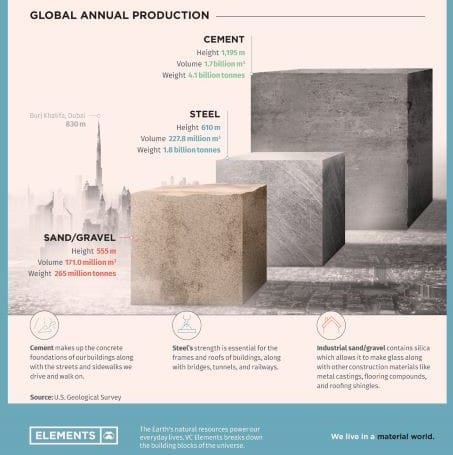Whenever I am in a big city, one of the first things I do is to orient myself and figure out in which direction the ocean is, and go there.
In coastal cities like Havana, Miami, San Diego and Dakar it’s easy. Niamey, Beijing, Paris and Berlin, less so.
I presume that the majority of today’s 4.3 billion people living in a city don’t have the same need to feel connected to the ocean. Why should they? And does that mean they don’t care about marine life?
With some 7 billion people living in cities by 2050, much support from the ocean is needed to sustain urban life; food, oxygen, energy, transport, reduce GHG emissions and plastic pollution, consumer goods etc.
Building cities
Cities only cover 2% of the world’s land surface, but activities within their boundaries consume over 75% of the planet’s material resources. The world’s material consumption is expected to grow from 41.1 billion tons in 2010 to about 89 billion by 2050. Much of this is sand, cement and steel.
4.1 bn tons of cement in 2021
We need huge loads of sand, cement and steel to rehabilitate and build new cities, which will emit lots of CO2 (cement production alone emits 7-8% of the global total, which in turn heat and make the ocean more acid). I wonder how Saudi Arabia’s mega project, The Line, if ever built, fits into this.

People care
The researchers behind a 2011 poll pointed out the lack of surveys on people’s perceptions on climate change and the marine environment, or “ocean literacy“. This has changed.
‘Ocean literacy’ can be defined as the understanding of our individual and collective impact on the Ocean and its impact on our lives and wellbeing.
This survey found that respondents were least aware of ocean acidification and most aware of melting sea ice, pollution and overfishing. Respondents from coastal areas claimed to be both more informed and more concerned than those living inland.
In a 2021 poll in England and Wales (they are surrounded by the ocean, remember), 85% of people say marine protection is personally important to them with 78% of the public stating that they have or would make lifestyle changes to protect the marine environment.
A 2022 poll found that Americans support policies to reduce water pollution (86%), protect threatened and endangered marine species (85%), and reduce single use plastic pollution (76%).
Cities do care
More people in urban areas means more power to cities and those governing them. Launched in 2008, the Global Covenant of Mayors for Climate & Energy envision a low-emission and climate-resilient future. It has over 12,500 signatories across 144 countries. Over 1 billion people live in a city or local government that is committed to GCoM.
Can Montreal protect the ocean?
Ironically, we will do more damage to the ocean to reach zero emission targets, to preserve it.
It’s good news that world leaders agree to conserve at least 30% of land, freshwater and ocean globally. But ocean protection goes far beyond the 14 pages final Montreal-Kunming agreement.

New and old, warm and cold cities
City systems is key to cut GHG emissions, as described in this World Bank post: Many older cities have inherited carbon-intensive infrastructure. More populous cities have more emissions, while higher-income cites have fewer emissions-intensive heavy industries. Higher-income cities have higher land costs and stricter pollution regulations; and cities in particularly cold or hot climates produce more emissions from energy for heating or cooling. Decarbonization by different cities must be rated against benchmarks that account for these innate differences.
Ocean grabs
Human-made structures, like artificial barriers, commercial and tourist ports, tunnels and bridges, oil platforms, wind farms, aquaculture infrastructures, in the oceans globally are now changing an area of over 2 million square kilometers. It will continue to expand further by 50-70% by 2028.
This is in proportion comparable to the extension of urban land with respect to the total land.
Build to survive
In 30 years the sea will penetrate the whole of Ho Chi Minh in Vietnam. The heart of Shanghai will be flooded. The same will happen with Alexandria in Egypt. This happens with sea level rise of 30-50 cm. In 80 years, the increase is expected to double.
As Jakarta is sinking into the Java sea, Indonesia is planning a new capital, Nusantara, on the island of Borneo.
Insurance companies in Florida go bankrupt due to record natural disasters losses, rising inflation, and unprecedented litigation costs arising from claim disputes. Premiums rise at alarming rates, making it unaffordable for many to own and maintain a home.
Conclusion? Cities consume, pollute and emit. But, key decisions too, good or bad, by individuals, governments and businesses mostly happen in cities. So does innovation. Since many of the world’s megacities (10 million+ inhabitants) are coastal, let’s hope that more people become ocean literate and realise how much we depend on the big blue.
Featured image: Boston 2019 during summer school at Harvard.





